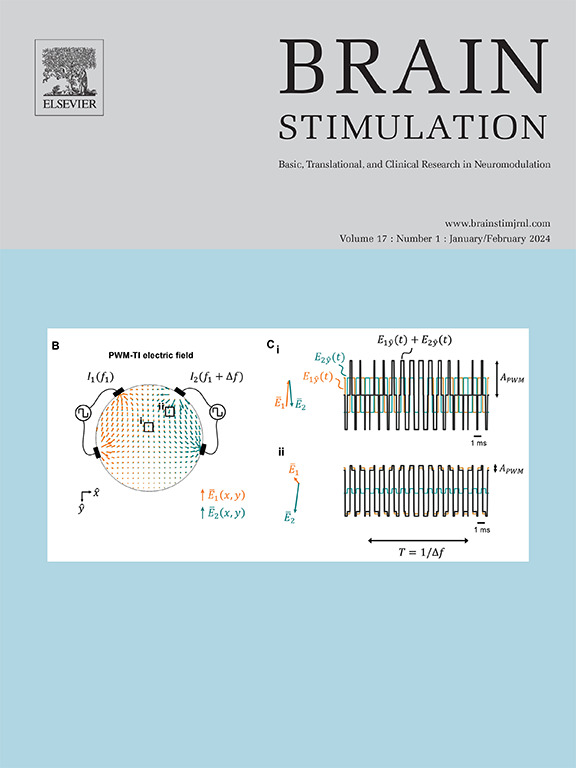A novel home-based, combined occipital and trigeminal afferent stimulation therapy for major depressive disorder: Efficacy and safety results from a double-blind multicenter randomized sham-controlled study
IF 8.4
1区 医学
Q1 CLINICAL NEUROLOGY
引用次数: 0
Abstract
Objective
Patients with Major Depressive Disorder (MDD) who fail to achieve satisfactory benefits with existing antidepressants have limited treatment options. This study assessed the safety and efficacy of a novel non-invasive brain neuromodulation therapy which delivers external Combined Occipital and Trigeminal Afferent Stimulation (eCOT-AS) as a therapeutic option for MDD.
Methods
124 adults with MDD who failed to respond to antidepressants and with a baseline Hamilton Depression Rating Scale (HDRS21) score ≥20 were enrolled in a randomized, double-blind, sham-controlled, multicenter study of self-administered daily active or sham eCOT-AS (n = 62 per arm) for eight weeks. The double-blind phase was followed by an 8-week active open label phase. HDRS17 was used to assess outcomes.
Results
Baseline depression scores were similar for both groups and reflected moderate to very severe depression. After 8 weeks of treatment, the adjusted mean HDRS17 improvement in the active treatment group was 8.62 points versus 6.01 for sham (p = 0.0196). Compared to sham treatment, participants receiving active treatment had significantly higher remission rates (21.3 % vs 6.0 %, p = 0.027) and achieved significantly more shifts to lower HDRS17 depression severity categories. Participants further improved during the subsequent eight weeks of open-label active stimulation with a mean reduction of almost 10 points from baseline and achieved a remission rate of 32 %. The treatment was well-tolerated with generally mild and transient adverse events.
Conclusion
This home-based brain neuromodulation system is safe and effective in treating depression. These findings support eCOT-AS as a promising new adjunct therapy for MDD patients with nonresponse to antidepressants.
一种新的以家庭为基础,枕叶和三叉神经传入刺激联合治疗重度抑郁症:来自双盲多中心随机假对照研究的疗效和安全性结果。
目的:重度抑郁障碍(MDD)患者使用现有抗抑郁药物无法获得满意的疗效,其治疗选择有限。这项研究评估了一种新的无创脑神经调节疗法的安全性和有效性,该疗法通过外部联合枕叶和三叉神经传入刺激(eCOT-AS)作为MDD的治疗选择。方法:124名对抗抑郁药无效且基线汉密尔顿抑郁评定量表(HDRS21)评分≥20分的MDD成年患者被纳入一项随机、双盲、假对照、多中心研究,每天(30-40分钟)自我服用活性或假eCOT-AS (n=62 /组),持续8周。双盲期之后是为期8周的开放标签期。HDRS17用于评估结果。结果:两组的基线抑郁评分相似,反映了中度到非常严重的抑郁。治疗8周后,积极治疗组调整后的平均HDRS17改善为8.62分,而假治疗组为6.01分(p=0.0196)。与假治疗相比,接受积极治疗的参与者有显著更高的缓解率(21.3% vs 6.0%, p=0.027),并且显著更多地转向低HDRS17抑郁严重程度类别。在随后的八周开放标签主动刺激中,参与者进一步改善,平均比基线降低了近10点,缓解率达到32%。治疗耐受性良好,不良反应一般轻微且短暂。结论:基于家庭的脑神经调节系统治疗抑郁症安全有效。这些发现支持eCOT-AS作为抗抑郁药无反应的重度抑郁症患者的一种有希望的新辅助疗法。
本文章由计算机程序翻译,如有差异,请以英文原文为准。
求助全文
约1分钟内获得全文
求助全文
来源期刊

Brain Stimulation
医学-临床神经学
CiteScore
13.10
自引率
9.10%
发文量
256
审稿时长
72 days
期刊介绍:
Brain Stimulation publishes on the entire field of brain stimulation, including noninvasive and invasive techniques and technologies that alter brain function through the use of electrical, magnetic, radiowave, or focally targeted pharmacologic stimulation.
Brain Stimulation aims to be the premier journal for publication of original research in the field of neuromodulation. The journal includes: a) Original articles; b) Short Communications; c) Invited and original reviews; d) Technology and methodological perspectives (reviews of new devices, description of new methods, etc.); and e) Letters to the Editor. Special issues of the journal will be considered based on scientific merit.
 求助内容:
求助内容: 应助结果提醒方式:
应助结果提醒方式:


